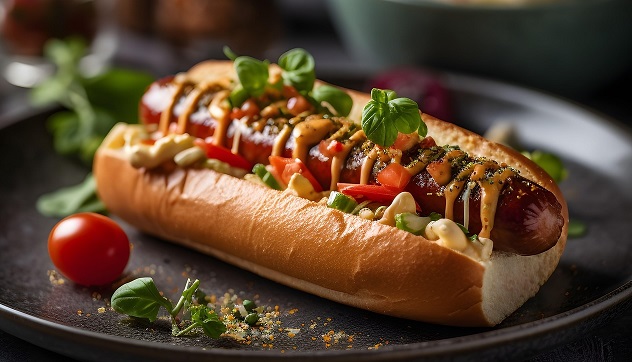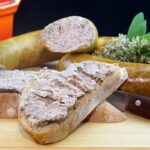
Long, slender, and lightly smoked, the Frankfurter Würstchen is Germany’s closest cousin to the American hot dog – and in fact, it came first. This mild, finely textured sausage is traditionally served warm with bread, mustard, and potato salad, and has been a favorite in Frankfurt for centuries.
Unlike its American descendant, the Frankfurter Würstchen is protected by law – only sausages produced in the Frankfurt region using specific methods can bear the official name. But beyond legal definitions, this sausage is an enduring symbol of German craftsmanship and culinary simplicity.
In this article, you’ll learn where the Frankfurter Würstchen comes from, how it’s made, and how best to prepare and serve it the traditional way.
What Is Frankfurter Würstchen?
Frankfurter Würstchen (literally “little sausages from Frankfurt”) are mildly smoked pork sausages with a smooth, pale pink interior. They are fully cooked during production and only require reheating before serving.
Key Traits:
- Made from finely ground pork
- Stuffed into sheep casings for a delicate snap
- Lightly smoked over beechwood
- Traditionally sold in pairs, linked together
Unlike hot dogs, Frankfurters contain no fillers, are less salty, and use only natural casings. Their flavor is gentle, mildly smoky, and extremely versatile.
Protected Status
In Germany, “Frankfurter Würstchen” is a protected geographical indication (PGI). Since 1929, only sausages made in the Frankfurt area using traditional methods may bear the name. Others must be labeled simply as “Wiener Würstchen” or “Saitenwürstle”.
This distinction is part of what preserves the sausage’s unique identity in a sea of imitations.
Ingredients and Flavor Profile
Standard Ingredients:
- Lean pork
- Fatback or pork belly
- Salt
- Curing salt
- White pepper
- Paprika or nutmeg
- Optional: light garlic or mustard powder
The meat is emulsified into a smooth paste before stuffing, similar to the process used in hot dog production, but with higher quality standards and no fillers.
How Frankfurter Würstchen Is Made
Step-by-Step Production:
- Grind pork and fat into a fine, uniform texture using chilled equipment.
- Add curing salt and spices, mixing until the mixture forms a smooth emulsion.
- Stuff into natural sheep casings (approximately 20–22 mm diameter).
- Twist into 15–18 cm links, typically in pairs.
- Cold smoke over beechwood at 18–22°C for several hours until lightly colored and aromatic.
- Fully cook the sausages in hot water (poaching stage), then chill and package.
The finished product is shelf-stable when vacuum-packed, and needs only gentle reheating before eating.
How to Cook Frankfurter Würstchen
Frankfurters are never boiled or grilled. Doing so would burst their delicate casing and ruin their subtle texture.
Traditional Method:
- Bring a pot of water to a gentle simmer (not boil).
- Remove from heat.
- Add sausages and let sit for 6-8 minutes until warmed through.
- Serve immediately.
Do not microwave or fry – the natural casing is delicate and best preserved with careful heating.
How to Serve Frankfurter Würstchen
Frankfurters are always served hot, but not browned. They’re a traditional part of both everyday meals and festive spreads.
Classic Serving Ideas:
- With yellow or spicy mustard
- Alongside potato salad, sauerkraut, or bread rolls
- With horseradish, gherkin pickles, or hard-boiled eggs on the side
Beverage Pairings:
- Apfelwein (apple cider) – a Frankfurt classic
- Pilsner or Helles lager
- Still mineral water or apple spritzer for a non-alcoholic pairing
Find more side dish inspiration in German Potato Salad.
Frankfurter vs. Wiener vs. Hot Dog
- Frankfurter Würstchen: All pork, light smoke, delicate snap, protected term in Germany
- Wiener Würstchen: Very similar, typically includes veal, more common outside Frankfurt
- American Hot Dog: Inspired by both, but typically contains beef/pork blend, artificial casing, and more salt
While they look alike, the German original is cleaner in flavor, shorter in ingredients, and softer in texture.
Storage and Shelf Life
- Vacuum-packed: 2-3 weeks refrigerated
- Opened: Use within 3-4 days
- Freezing: Not recommended – affects texture
Store in original packaging or a sealed container. Do not reheat more than once.
Fun Facts About Frankfurter Würstchen
- Frankfurt’s sausages are historically linked to royal coronations, where they were served at feasts.
- The term “hot dog” came from German immigrants bringing Frankfurters and Wieners to the U.S.
- In Germany, kids often eat Frankfurters with ketchup and white bread rolls.
- A “Wiener Würstchen” made outside Frankfurt cannot legally be called a Frankfurter – even in Frankfurt!
Mild, elegant, and full of tradition, the Frankfurter Würstchen is more than a hot dog – it’s a culinary symbol of simplicity done right. Whether served with potato salad or on its own with mustard, it remains one of Germany’s most recognizable sausages for good reason.
To explore more smoked sausages, try the garlicky Knackwurst or the Alpine favorite Landjäger.







